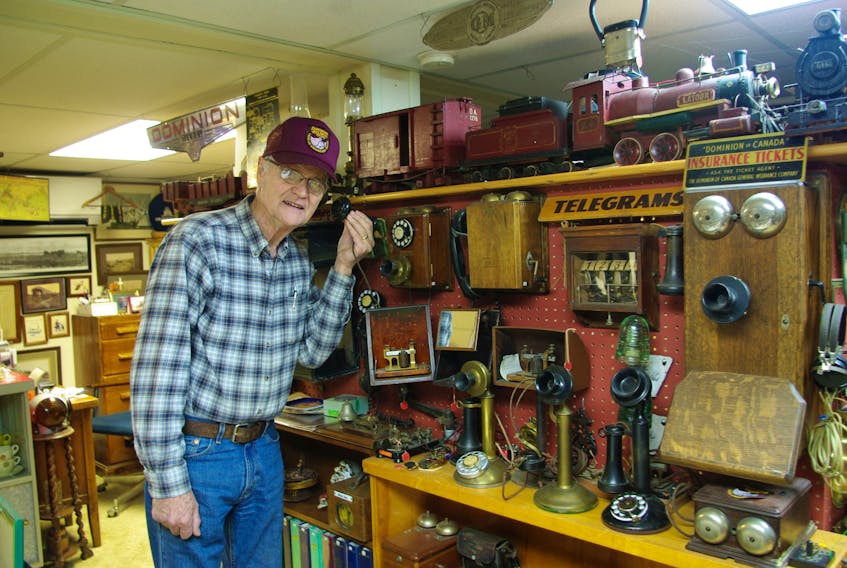The fate of the railway in the Valley was sealed in the late 1980s when Highway 101 between Kentville and Yarmouth was completed.
Now, decades later, the abandoned railbeds are walking trails and the only visible remnants indicating the railway was once here.
As for other remnants, a few books of railway history have been published, with at least one focusing on the Annapolis Valley. Some museums have token railway displays; only a few, such as the Macdonald Museum in Middleton with its all-encompassing exhibit, celebrates the fact that this was once a railway hub.
Besides museum exhibits, some remnants of the railway also can be found in private collections. Put together by people with a passionate interest in the railway and its lore, these collections are priceless; since they preserve artifacts and historic material that surely would have been lost forever, calling the collections “priceless” doesn’t say enough about their value.
One such private collection, an extensive one, was put together by Tony Kalkman over a 30-year period. A Kentville resident, self-employed during his working life and now retired, Kalkman began collecting railway artifacts and other lore around the time lines were closing in the Valley. This, says Kalkman, was a coincidence – the lines closing when he started his collection - since he always had a keen interest in collecting railway artifacts.
Kalkman’s collected so much railway memorabilia over the years that to store it, he’s turned his basement into what amounts to a mini-museum. He’s actually lost count of how much stuff he’s collected – “it’s well over a thousand artifacts,” he says – and there’s probably enough stuff, minus a steam locomotive, to stock half a dozen railways and get them up and running.
Take that back: he does have a locomotive in his collection, a miniature duplicate of one of the old steam engines that huffed and puffed up and down the Valley a hundred years ago. The engine (and matching miniature boxcars) was made by a local craftsman from odds and ends of material you’d find around junkyards, what Kalkman calls “tramp art.”

Now, Kalkman saying he has an interest in the railway is putting it modestly. He has one of the largest private collections of railway artifacts, documents and photographs that can be found in the Annapolis Valley, and possibly in Nova Scotia. Best of all, his collection is organized in such a way that it’s a panorama of provincial and Annapolis Valley railway history. Here, for example, are artifacts from the first railway to run through the Valley. This was the Windsor and Annapolis Railway (W&AR), which officially opened in 1869. Kalkman has hundreds of artifacts as well from the Dominion Atlantic Rail, which was a merger of the W&AR with the Annapolis and Yarmouth Railways in 1894, and memorabilia from the Canadian Pacific Railway. Included also are artifacts from the Intercolonial Railway, which first laid rails from New Brunswick into Halifax away back in 1867.
To sum up what’s in Kalkman’s collection, it’s safe to say that everything the railway once required to serve the public, keep the locomotives running and the stations open, can be found in it. In the collection are historical documents, an 1867 coach seat, light and heavy tools, clocks and locks, telegraph keys, telephones, dishes, silverware, lanterns, conductor’s hats and whistles, locomotive whistles, and switch lights, many of them antique and many stamped with railway logos.
One of Kalkman’s most treasured artifacts is the original DAR timetable, made up in 1894 when the merger with the W&AR and the western railways took place. The first artifact he collected was a broad axe that was made for the W&AR, most likely in the mid-1800s. The axe is stamped “W&AR, Cornwallis,” and has the maker’s name, D. Eaton. The axe may have been made in Sheffield Mills since “Cornwallis” is a broad term taking in all the county north of the Cornwallis River. An Eaton was making axes in the Sheffield Mills area of Cornwallis around the time the A & WR got up and running and it likely came from his shop.
As well as artifacts and other railway memorabilia, Kalkman also collects postcards with railway themes, a collection he eventually turned into a book. Along the Tracks, 98 pages of postcards and railway photographs, was self-published 18 years ago and is still in print.
The work of iconic Kentville photographer, A. L Hardy (1860-1935) is also well represented in Kalkman’s collection. He has in excess of 100 Hardy photographs – Kalkman isn’t sure of the exact number - and many of them are of historical railway scenes such as the various stations on the line.
Most of the artifacts in Kalkman’s collection came from his digging around in the country, talking with people whose fathers and grandfathers worked for the railway. His best sources were auctions, yard sales and online sites such as Kijiji and the like. “After people heard I was collecting,” he says, “word of mouth helped as well.”
Kalkman says it took a lot of time and effort over the past 30 years to put his collection together and he’s still adding to it today.
“I’m hoping one day to find a Dominion Atlantic Railway lantern for my collection,” he says. “This is one artifact that’s been the hardest to find but I’m sure there’s one out there somewhere.”









